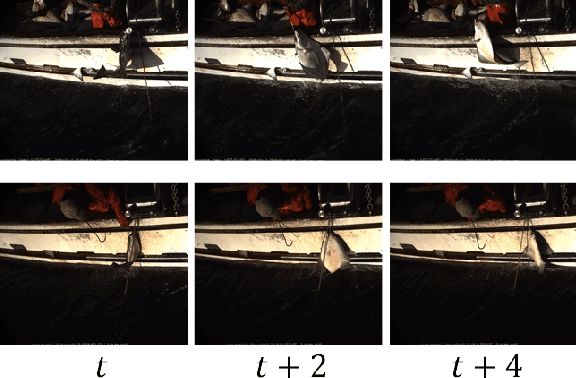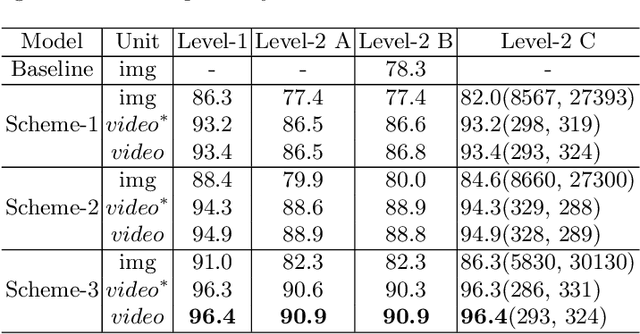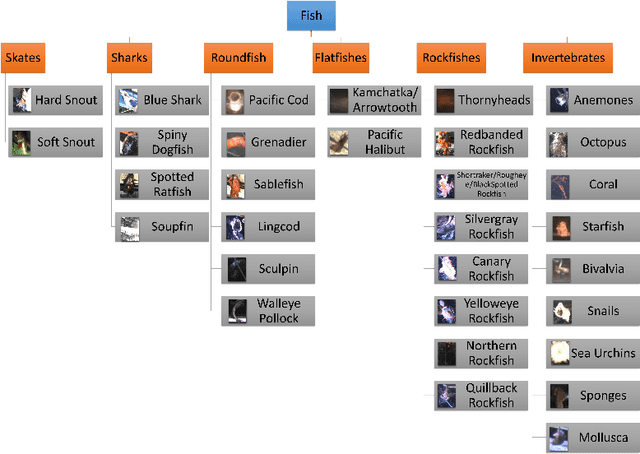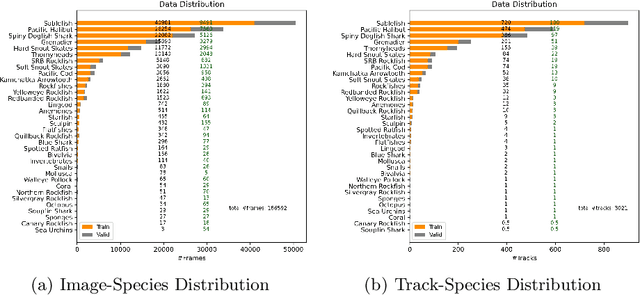Craig Rose
HCIL: Hierarchical Class Incremental Learning for Longline Fishing Visual Monitoring
Feb 25, 2022



Abstract:The goal of electronic monitoring of longline fishing is to visually monitor the fish catching activities on fishing vessels based on cameras, either for regulatory compliance or catch counting. The previous hierarchical classification method demonstrates efficient fish species identification of catches from longline fishing, where fishes are under severe deformation and self-occlusion during the catching process. Although the hierarchical classification mitigates the laborious efforts of human reviews by providing confidence scores in different hierarchical levels, its performance drops dramatically under the class incremental learning (CIL) scenario. A CIL system should be able to learn about more and more classes over time from a stream of data, i.e., only the training data for a small number of classes have to be present at the beginning and new classes can be added progressively. In this work, we introduce a Hierarchical Class Incremental Learning (HCIL) model, which significantly improves the state-of-the-art hierarchical classification methods under the CIL scenario.
Unsupervised Severely Deformed Mesh Reconstruction (DMR) from a Single-View Image
Jan 23, 2022



Abstract:Much progress has been made in the supervised learning of 3D reconstruction of rigid objects from multi-view images or a video. However, it is more challenging to reconstruct severely deformed objects from a single-view RGB image in an unsupervised manner. Although training-based methods, such as specific category-level training, have been shown to successfully reconstruct rigid objects and slightly deformed objects like birds from a single-view image, they cannot effectively handle severely deformed objects and neither can be applied to some downstream tasks in the real world due to the inconsistent semantic meaning of vertices, which are crucial in defining the adopted 3D templates of objects to be reconstructed. In this work, we introduce a template-based method to infer 3D shapes from a single-view image and apply the reconstructed mesh to a downstream task, i.e., absolute length measurement. Without using 3D ground truth, our method faithfully reconstructs 3D meshes and achieves state-of-the-art accuracy in a length measurement task on a severely deformed fish dataset.
Absolute 3D Pose Estimation and Length Measurement of Severely Deformed Fish from Monocular Videos in Longline Fishing
Feb 09, 2021



Abstract:Monocular absolute 3D fish pose estimation allows for efficient fish length measurement in the longline fisheries, where fishes are under severe deformation during the catching process. This task is challenging since it requires locating absolute 3D fish keypoints based on a short monocular video clip. Unlike related works, which either require expensive 3D ground-truth data and/or multiple-view images to provide depth information, or are limited to rigid objects, we propose a novel frame-based method to estimate the absolute 3D fish pose and fish length from a single-view 2D segmentation mask. We first introduce a relative 3D fish template. By minimizing an objective function, our method systematically estimates the relative 3D pose of the target fish and fish 2D keypoints in the image. Finally, with a closed-form solution, the relative 3D fish pose can help locate absolute 3D keypoints, resulting in the frame-based absolute fish length measurement, which is further refined based on the statistical temporal inference for the optimal fish length measurement from the video clip. Our experiments show that this method can accurately estimate the absolute 3D fish pose and further measure the absolute length, even outperforming the state-of-the-art multi-view method.
Video-based Hierarchical Species Classification for Longline Fishing Monitoring
Feb 06, 2021



Abstract:The goal of electronic monitoring (EM) of longline fishing is to monitor the fish catching activities on fishing vessels, either for the regulatory compliance or catch counting. Hierarchical classification based on videos allows for inexpensive and efficient fish species identification of catches from longline fishing, where fishes are under severe deformation and self-occlusion during the catching process. More importantly, the flexibility of hierarchical classification mitigates the laborious efforts of human reviews by providing confidence scores in different hierarchical levels. Some related works either use cascaded models for hierarchical classification or make predictions per image or predict one overlapping hierarchical data structure of the dataset in advance. However, with a known non-overlapping hierarchical data structure provided by fisheries scientists, our method enforces the hierarchical data structure and introduces an efficient training and inference strategy for video-based fisheries data. Our experiments show that the proposed method outperforms the classic flat classification system significantly and our ablation study justifies our contributions in CNN model design, training strategy, and the video-based inference schemes for the hierarchical fish species classification task.
 Add to Chrome
Add to Chrome Add to Firefox
Add to Firefox Add to Edge
Add to Edge